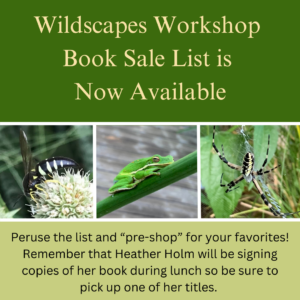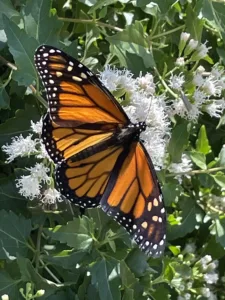The Wildscapes Workshop and Plant Sale is an annual one-day educational event, silent auction, book sale, and local plant sale we organize, normally held in late September or early October. Stay tuned for information about our 2024 event!
The presentations will also be available to watch via Zoom. You can register at the same link and choose the Zoom option.
See the posts below for information about last year’s workshop.

Book Sale
Wildscapes Workshop will be selling books relevant to growing native habitat, including award-winning titles from our keynote speaker Heather Holm!

Agenda
Wildscapes Workshop features expert speakers who will inform and delight us with their knowledge of some of our most under-appreciated garden visitors.

Plant Sale
Wildscapes Workshop features a unique opportunity for attendees to purchase high-quality local native plants. Watch here for a list of available plants.

Call for Volunteers
The Wildscapes Workshop planning committee is recruiting volunteers for this year’s event.

Speakers
Wildscapes Workshop features expert speakers who will inform and delight us with their knowledge of some of our most under-appreciated garden visitors.

Sponsorships
Please consider becoming a sponsor of our 2023 Wildscapes Workshop. All proceeds support our mission to promote research, conservation and utilization of native plants and plant habitats of Texas through education, outreach and example. We are grateful for donations of any size. For more information please download our Sponsorship Flyer below.
Sponsorships will be open from August 1st to September 12.
Become a Sponsor
1) Decide your sponsorship level.
2) ALL sponsors must fill out this form so we can send you a receipt for tax purposes.
3) Go to the eventbrite registration link. Click “Register”. Enter the amount of the donation. Your sponsorship level will depend on the amount donated. (Be sure also to choose “registration”, if you want to attend the workshop and plant sale.)
OR if you wish to make a donation by check, please make checks payable to ‘NPSOT-H’ with “WW Sponsor” on the memo line and mail to: NPSOT-Houston, P.O. Box 131254, Houston, TX 77219-1254. (Note: This WILL NOT register you for the workshop. Registration for the workshop is only through Eventbrite.)
4) For more information, contact nphouston1@gmail.com.
Your sponsorship will be publicized after we receive your donation!
Deadline to be publicized is September 12.
Donations DO NOT register you for the Workshop.
